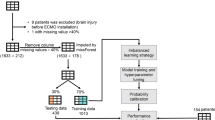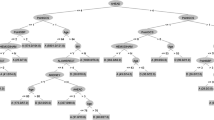Abstract
This study sought to determine a mortality prediction model that could be used for triage in the setting of acute hemorrhage from trauma. To achieve this aim, various machine learning techniques were applied using the rat model in acute hemorrhage. Thirty-six anesthetized rats were randomized into three groups according to the volume of controlled blood loss. Measurements included heart rate (HR), systolic and diastolic blood pressures (SBP and DBP), mean arterial pressure, pulse pressure, respiratory rate, temperature, blood lactate concentration (LC), peripheral perfusion (PP), shock index (SI, SI = HR/SBP), and a new hemorrhage-induced severity index (NI, NI = LC/PP). NI was suggested as one of the good candidates for mortality prediction variable in our previous study. We constructed mortality prediction models with logistic regression (LR), artificial neural networks (ANN), random forest (RF), and support vector machines (SVM) with variable selection. The SVM model showed better sensitivity (1.000) and area under curve (0.972) than the LR, ANN, and RF models for mortality prediction. The important variables selected by the SVM were NI and LC. The SVM model may be very helpful to first responders who need to make accurate triage decisions and rapidly treat hemorrhagic patients in cases of trauma.





Similar content being viewed by others
References
Agranoff D, Fernandez-Reyes D, Papadopoulos MC, Rojas SA, Herbster M, Loosemore A, Tarelli E, Sheldon J, Schwenk A, Pollok R, Rayner CF, Krishna S (2006) Identification of diagnostic markers for tuberculosis by proteomic fingerprinting of serum. Lancet 368(9540):1012–1021
American College of Surgeons (2008) ATLS: advanced trauma life support for doctors (student course manual), 8th edn. Am Coll of Surg, Chicago
Benedek DM, Fullerton C, Ursano RJ (2007) First responders: mental health consequences of natural and human-made disasters for public health and public safety workers. Annu Rev Public Health 28:55–68
Birkhahn RH, Gaeta TJ, Terry D, Bove JJ, Tloczkowski J (2005) Shock index in diagnosing early acute hypovolemia. Am J Emerg Med 23(3):323–326
Choi JY, Kim SK, Lee WH, Yoo TK, Kim DW (2012) A survival prediction model of rats in hemorrhagic shock using the random forest classifier. Proceedings of the 34th International Conference of the IEEE Engineering in Medicine and Biology Society, San Diego, IEEE Service Center, Piscataway, NJ, pp 5570–5573. doi: 10.1109/IEMBS.2012.6347256
Choi JY, Lee WH, Yoo TK, Park I, Kim DW (2012) A new severity predicting index for hemorrhagic shock using lactate concentration and peripheral perfusion in a rat model. Shock 38(6):635–641
Cortes C, Vapnik V (1995) Support-vector networks. Mach Learn 20(3):273–297
Dash M, Liu H (2003) Consistency-based search in feature selection. Artif Intell 151(1–2):155–176
Davis JA (2008) Mouse and rat anesthesia and analgesia. Curr Protoc Neurosci (Appendix 4: Appendix 4B). doi:10.1002/0471142301.sna04bs42
Dutton RP (2007) Current concepts in hemorrhagic shock. Anesthesiol Clin 25(1):23–34
Eftekhar B, Mohammad K, Ardebili HE, Ghodsi M, Ketabchi E (2005) Comparison of artificial neural network and logistic regression models for prediction of mortality in head trauma based on initial clinical data. BMC Med Inform Decis Mak 5:3
Hsieh CH, Lu RH, Lee NH, Chiu WT, Hsu MH, Li YC (2011) Novel solutions for an old disease: diagnosis of acute appendicitis with random forest, support vector machines, and artificial neural networks. Surgery 149(1):87–93
Huang J, Ling CX (2005) Using AUC and accuracy in evaluating learning algorithms. IEEE Trans Knowl Data Eng 17(3):299–310
Jang KH, Yoo TK, Choi JY, Nam KC, Choi JL, Kwon MK, Kim DW (2011) Comparison of survival predictions for rats with hemorrhagic shocks using an artificial neural network and support vector machine. Proceedings of the 33rd International Conference of the IEEE Engineering in Medicine and Biology Society, Boston, IEEE Service Center, Piscataway, NJ, pp 91–94 doi:10.1109/IEMBS.2011.6089904
Kauvar DS, Lefering R, Wade CE (2006) Impact of hemorrhage on trauma outcome: an overview of epidemiology, clinical presentations, and therapeutic considerations. J Trauma 60(Suppl. 6):S3–S11
Lerner EB, Schwartz RB, Coule PL, Weinstein ES, Cone DC, Hunt RC, Sasser SM, Liu JM, Nudell NG, Wedmore LS, Hammond J, Bulger EM, Salomone JP, Sanddal TL, Markenson D, O′Connor RE (2008) Mass casualty triage: an evaluation of the data and development of a proposed national guideline. Disaster Med Public Health Prep 2(Suppl 1):S25–S34
Letson HL, Dobson GP (2011) Unexpected 100% survival following 60% blood loss using small-volume 7.5% NaCl with adenocaine and Mg (2+) in the rat model of extreme hemorrhagic shock. Shock 36(6):586–594
Lomas-Niera JL, Perl M, Chung CS, Ayala A (2005) Shock and hemorrhage: an overview of animal models. Shock 24(Suppl 1):33–39
Macias CA, Kameneva MV, Tenhunen JJ, Puyana JC, Fink MP (2004) Survival in a rat model of lethal hemorrhagic shock is prolonged following resuscitation with a small volume of a solution containing a drag-reducing polymer derived from aloe vera. Shock 22(2):151–156
Mukkamala S, Janoski G, Sung A (2002) Intrusion detection using neural networks and support vector machines. Proceedings of the 2002 International Joint Conference on Neural Networks, pp 1702–1707. doi:10.1109/IJCNN.2002.1007774
Nakasone Y, Ikeda O, Yamashita Y, Kudoh K, Shigematsu Y, Harada K (2007) Shock index correlates with extravasation on angiographs of gastrointestinal hemorrhage: a logistics regression analysis. Cardiovasc Intervent Radiol 30(5):861–865
Not LG, Marchase RB, Fulop N, Brocks CA, Chatham JC (2007) Glucosamine administration improves survival rate after severe hemorrhagic shock combined with trauma in rats. Shock 28(3):345–352
Roberts DA, Holcomb JB, Parker BE Jr, Sondeen JL, Pusateri AE, Brady WJ Jr, Sweenor DE, Young JS (2002) The use of polynomial neural networks for mortality prediction in uncontrolled venous and arterial hemorrhage. J Trauma 52(1):130–135
Saeys Y, Inza I, Larrañaga P (2007) A review of feature selection techniques in bioinformatics. Bioinforma 23(19):2507–2517
Schull MJ, Morrison LJ, Vermeulen M, Redelmeier DA (2003) Emergency department overcrowding and ambulance transport delays for patients with chest pain. CMAJ 168(3):277–283
Statnikov A, Wang L, Aliferis CF (2008) A comprehensive comparison of random forests and support vector machines for microarray-based cancer classification. BMC Bioinformatics 9:319. doi:10.1186/1471-2105-9-319
Takasu A, Sakamoto T, Okada Y (2006) Effect of induction rate for mild hypothermia on survival time during uncontrolled hemorrhagic shock in rats. J Trauma 61(6):1330–1335
Waldron L, Pintilie M, Tsao MS, Shepherd FA, Huttenhower C, Jurisica I (2011) Optimized application of penalized regression methods to diverse genomic data. Bioinformatics 27(24):3399–3406
Wilson M, Davis DP, Coimbra R (2003) Diagnosis and monitoring of hemorrhagic shock during the initial resuscitation of multiple trauma patients: a review. J Emerg Med 24(4):413–422
World Health Organization (2010) World health statistics 2010. Switzerland, World Health Organization Press, Geneva, pp 62–70
Yang S, Zou LY, Bounelis P, Chaudry I, Chatham JC, Marchase RB (2006) Glucosamine administration during resuscitation improves organ function after trauma hemorrhage. Shock 25(6):600–607
Zhao ZD, Lou YY, Ni JH, Zhang J (2012) RBF-SVM and its application on reliability evaluation of electric power system communication network. In: Machine Learning Cybernetics (ICMLC), 2012 Annual International Conference of the IEEE, pp.1188–1193. doi: 10.1109/ICMLC.2009.5212365
Zou H, Hastie T (2008) Regularization and variable selection via the elastic net. J R Stat Soc Series B Stat Methodol 67(2):301–320
Acknowledgments
This study was supported by a faculty research Grant from Yonsei University College of Medicine for 2011 (6-2011-0087).
Author information
Authors and Affiliations
Corresponding author
Rights and permissions
About this article
Cite this article
Kim, KA., Choi, J.Y., Yoo, T.K. et al. Mortality prediction of rats in acute hemorrhagic shock using machine learning techniques. Med Biol Eng Comput 51, 1059–1067 (2013). https://doi.org/10.1007/s11517-013-1091-0
Received:
Accepted:
Published:
Issue Date:
DOI: https://doi.org/10.1007/s11517-013-1091-0




